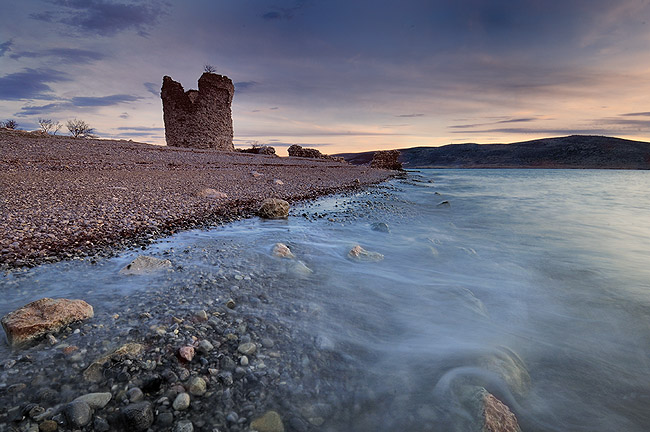Starigrad-Paklenica is a small town of just over one thousand inhabitants in northern Dalmatia. Sharing the common fate of small agricultural settlements in the twentieth century, it was faced with emigration as its people sought their fortune in large urban centers home and abroad. However, the road networks constructed in recent decades have reversed this trend. As the benefits of remoteness are no longer incompatible with easy access to modern comforts, the Starigrad community is now a prosperous center for rural tourism, sporting and recreational activities – such as climbing, hiking or mountain biking. But the name Starigrad (literally ‘old town’) hints at the existence of an earlier settlement at the location of the modern one – in this case, ancient Roman. It is fitting that ancient Romans whose patrician class ‘invented’ tourism also founded the original Starigrad, graced by its modern practitioners.
The predecessor to Starigrad was dubbed Argyruntum and it rose to municipal status in the 1st century AD in the reign of Emperor Tiberius. This occured shortly after the founding of the Roman province of Dalmatia, a portion of the rebellious Illyricum. The town dominated local life, initially by serving as a market for locally grown agricultural products and cattle. Even though the coastal rivers run dry in the summer months, the karst landscape and man-made wells retained enough water for livestock and their keepers. The land was arable and made for good pasture. A multitude of coves provided safe anchorage and facilitated the transportation of goods in a period when heavy loads were impossible to transport overland. The central settlement, placed on a peninsula which is joined with the mainland today, also served a strategic purpose overlooking the Velebit channel waterway.
All semblance of town life appears to have ceased in the fourth century, as the Roman Empire faltered under threat from external pressures and institutional decay. Control of distant provinces was relinquished first, but even in nearby Dalmatia Rome lost control in this late period. The local inhabitants reverted to the pre-Roman agricultural way of life on the slopes of Velebit which offered greater security to a civilian population. The natural wealth of the region had drawn the first settlers and remains a constant today, harboring a potential for olive groves, orchards, vegetable gardens, fisheries, beekeeping and cattle rearing. Hopefully these traditional industries will continue to yield high-quality local food products, forging another link with the past.
Argyruntum ghost stories
In an interesting turn of events, scientific interest in the Starigrad area revolves around the funeral customs of both its modern and ancient residents.
The people in the Velebit mountain area have always been scattered, with few major population centers. This led to a situation where several remote villages would gravitate to a single parish church, and considerable distances between a person’s home and their burial site, such that could not be traversed without stopping to rest. So the pallbearers were allowed a break halfway to the cemetery, where they would lay the remains on the ground and place stones near the head and feet of the deceased. Since this resembled a crude form of measuring height, these sites are known as ‘mirila’ (measures). Carved headstones and stone slabs would later be added by relatives and the sites, judged to be the true resting places of the souls, were revered more than the consecrated cemeteries. This practice continued from the 17th to the 20th century, and these folk monuments and customs relating to them are a protected cultural property and an iconic feature of the Paklenica landscape.
Most of what is known about life in Argyruntum is likewise derived from objects left to honor the town’s dead. The richest site of archaeological study is the necropolis situated along the ancient road entrance to the town. Since 1908, when Mihovil Abramić and Anton Colnago conducted the first excavation, ritual objects and offerings have been retrieved from four hundred vaults. These include jewelry made of bronze, silver, bone and amber, metalware, weapons, tools and ceramic and glass vessels of varying shape. The bulk of these treasures is kept in the Archaeological museum in Zadar. Objects such as numerous oil containers with as many as 25 different manufacturer’s seals point to the town being an important trading center. The most valuable ornamental objects were not products of local artisans. They originate from Cyprus, Egypt, Syria, Rome, Capua and Aquileia.
The continuity between the ancient and modern settlements does not stop there. The chapel of Saint George rests on the spot where a Roman temple used to stand. It’s not excluded that other parts of town retain their functionality. It is also likely that existing northern county limits reflect ancient Roman and even pre-Roman territorial divisions, as the mountain passes form natural obstacles to travel. Unlike the necropolis, not much of the ancient residential areas was preserved; only a short stretch of the ruined defensive wall. Despite the loss, we can reconstruct much of the life in Argyruntum through analogy and imagination, since we still share a lot of the same living conditions. Looking around Starigrad, we can remain neighbors with the ancients – living next door, but millenia apart.

Leave a Reply